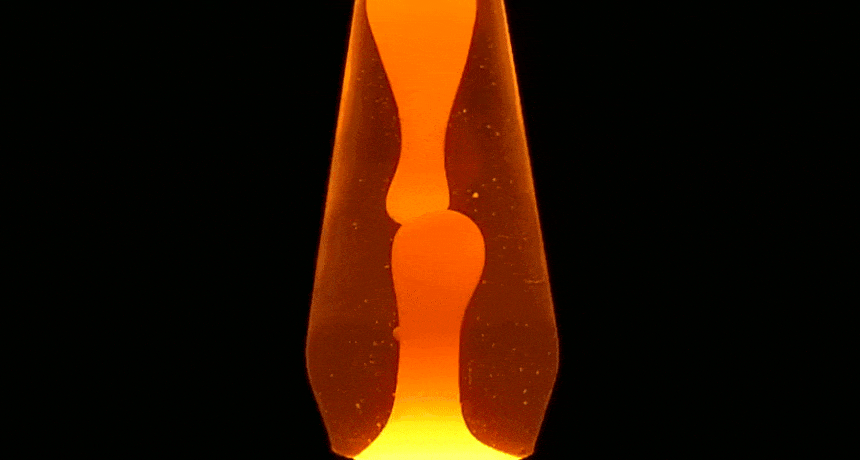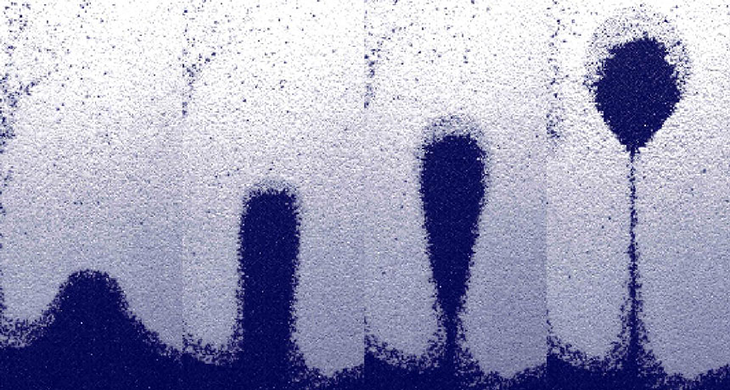Dry sand can bubble like the blobs in a lava lamp
All it takes is a jiggle and some gas to get the grains flowing

Dry sand grains of various densities can bubble like the blobs in this lava lamp, scientists find. Just add vibrations and gas.
Ricciardi Mario/Creatas Video+/GettyImagesPlus
Dry sand can flow like a liquid, a new study finds. All it takes are the right conditions. When heavy grains are placed atop lighter ones in a container, the lighter grains can burble upward like the blobs in a lava lamp.
Scientists had known that wet grains can act like liquids. Strong earthquakes, for instance, can “liquefy” solid sand that is soaked with water. Less well-known is how to mix grainy materials without water. Indeed, this research is the first to show how mixing dry sand grains can mimic fluids.
Understanding such flows could help scientists better explain the behavior of mudslides or explosive flows from volcanoes. The research could also help create uniform mixtures of particles for use in industries that make drugs, chemicals or foods. For instance, dry, grainy particles of different sizes and densities tend to move around one another. This causes them to separate out — or “demix” — says Richard Lueptow. He’s a mechanical engineer at Northwestern University in Evanston, Ill., who was not involved in the new study.
Researchers reported their new findings online April 22 in the Proceedings of the National Academy of Sciences.

Mix it up
Christopher McLaren is a mechanical engineer at ETH Zurich in Switzerland. His team placed two types of round grains in a thin glass chamber. A layer of heavy grains sat atop a layer of lighter ones. To get the grains moving, the team vibrated the chamber. They also sent gas upward through it.
The grains “flowed” around one another like liquids in a lava lamp would. Bubbles and fingerlike streams of lightweight grains rose to the top. Heavy grains flowed lower in the container.
Patterns like the ones seen in lava lamps form as a lighter fluid pushes its way into a denser fluid. This results from what physicists call the Rayleigh-Taylor instability. The new research shows for the first time that dry grains can mimic that instability.
That was unexpected. This instability is related to the fact that the fluids can’t mix together. But that’s not true for solid grains. They can mix fully — and yet didn’t.
“We realized there was a completely different realm of physical mechanisms [here],” says Christopher Boyce. An author of the new study, he works as a chemical engineer at Columbia University in New York City.
His team used a computer model to simulate how the grains would mix. It showed that the gas flow and vibrations controlled how the grains moved. Gas flowing through the chamber traveled differently between grains of different sizes and densities. That created upward drag. This force kept the lighter grains clumped together. Drag also stopped the clumps from mixing with heavy grains. It is somewhat like how oil and water might behave.
When the team changed the rate of gas flow or the vibration level, the grains formed larger fingers or bigger blobs. This showed that both the gas and the vibrations were crucial for the grains to mimic patterns of fluid instability.
Changing patterns
A different pattern emerged when researchers placed a blob of heavy grains within a layer of lighter ones. The grains behaved more like fluids that can mix — such as red dye in water.
Heavy grains split into two blobs that fell at an angle through the layer of lighter grains. The blobs split again and again in a branching pattern. That pattern also resulted from the flow of the gas up through the grains.
Past studies that used vibrations only had shown grains of different sizes can move around each other in fluidlike ways, says Paul Umbanhowar. He is a mechanical engineer, also at Northwestern University.
Those moves resulted from small grains slipping down between larger ones during the shaking. Bigger grains ended up on top. It’s much the way Brazil nuts will end up at the top of a shaken can of mixed nuts. In physics, this phenomenon is actually called the Brazil nut effect.
By adding gas flow, Umbanhowar concludes, the new results now are much more similar to the behavior of normal fluids.
C.P. McLaren et al/PNAS 2019







